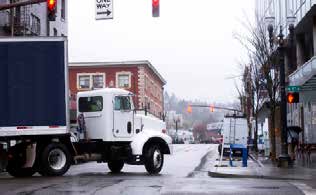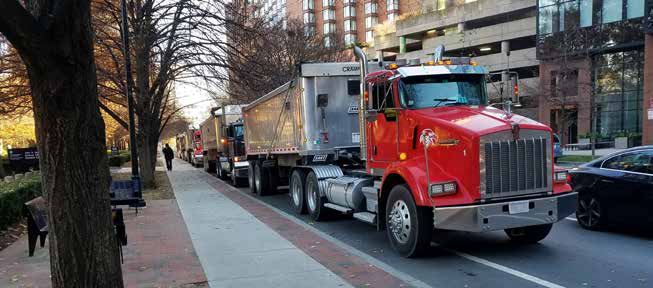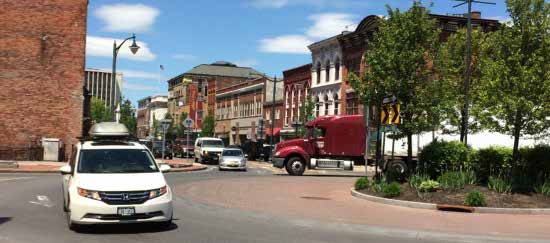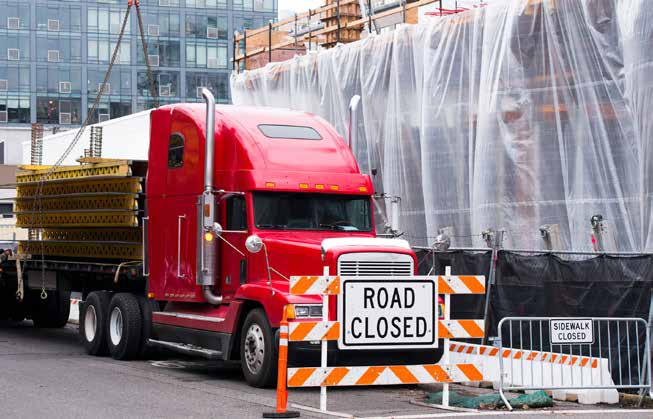Primer for Improved Urban Freight Mobility and Delivery
Operations, Logistics, and Technology Strategies
Benefits of Urban Freight Management
The benefits of urban freight management for cities and local residents and businesses include reduced infrastructure maintenance costs, improved mobility and traffic flow, enhanced information flow that can inform better decisions, reduced traffic incidents, more efficient deliveries, and reduced noise and air pollution. Freight carriers and shippers benefit from increased reliability of pick-ups and deliveries, more seamless truck parking, and new freight delivery technologies.
Infrastructure Preservation
The physical constraints of the urban environment, particularly in older cities, can make it difficult or impossible for larger freight delivery vehicles to use certain routes or access certain neighborhoods. These physical constraints include low overhead clearances, restricted roadway geometry, and weight-restricted bridges. Metropolitan regions may designate truck routes and implement warning systems to help freight vehicle operators better plan for and adjust their activities as needed. Increasingly, public agencies are using information and communications technologies to keep information on freight routes up-to-date, to provide better communication of information to carriers and providers of routing services, and to monitor and enforce carrier compliance with rules and restrictions. For example, the New York City DOT (NYCDOT) is using weigh-in-motion (WIM) technology to monitor truck activity on bridges and roadways on strategic freight corridors entering the city (see WIM Sensor Installation).

A tractor-trailer traveling an urban street. Source: Getty Images.
All vehicles, including trucks, have some impact on road conditions. Enforcement of truck size and weight limitations, as well as of city-specific access and route restrictions, can reduce infrastructure damage while also improving safety for all road users. For example, the City of New Orleans restricted delivery vehicles longer than 36 feet in length from accessing the French Quarter, one of the city's oldest neighborhoods. The French Quarter's historic homes and narrow roadways were at risk of damage from larger vehicles (see Ban on Large Trucks in French Quarter District, New Orleans, LA).

A line of construction vehicles waiting in city traffic. Source: Volpe National Transportation Systems Center.
Mobility/Traffic Flow
Trucks can increase roadway congestion in dense urban areas, particularly if receivers request deliveries during or near peak traffic times. Planning of local truck routes and access can reduce truck-related congestion. For example, Washington, DC, implemented a loading zone management program to reduce double parking. The effort improved mobility and traffic flow in the District's commercial areas without a substantial disruption of commercial activity (see Commercial Loading Zone Management Program (CLZMP) in Washington, DC). Similar planning efforts can improve delivery reliability and reduce instances of carriers missing delivery windows or making additional attempts to deliver a shipment. Improving mobility and traffic flow in urban environments can increase the reliability of freight deliveries, which benefits both the carriers and receivers of goods.

Downtown Glens Falls, NY. Source: Cambridge Systematics.
Truck drivers making first- and last-mile freight movements in urban areas sometimes have difficulty finding available loading areas, both on-street and off-street. There can be intense competition for the use of curb space in urban areas between loading zones and other uses, such as parking for light-duty vehicles, bus stops, fire hydrants, crosswalks, and bicycle lanes. Cities that provide an adequate supply or enforce proper use of loading zone spaces can improve traffic flow, shorten delivery times, and reduce double-parking infractions. For example, the City of Miami Beach implemented a loading zone permitting system to reduce double parking. The effort helped reduce traffic congestion during peak hours as well as noise from freight loading activities during off-hours (see City of Miami Beach Freight/Alley Loading Parking Permit Program).
Safety
Although urban roadways typically have lower speed limits than rural and suburban routes, these roadways also have higher traffic densities and a diverse mix of road users. As a result, trucks traveling on urban roadways can present more opportunities for conflicts with other road users. In 2015, more than 1,400 people were killed in traffic crashes involving large trucks in urban areas. Approximately nine percent of all fatal crashes in urban areas involve a large truck. Maintaining lower speed limits and buffering trucks from other road users when possible can help prevent collisions.
It is also important to consider how the design of trucks and other large delivery vehicles affects travel in urban areas. Trucks have higher ground clearances and mechanical limitations to maneuverability that can affect the way trucks interact with infrastructure and other road users in urban areas with mixed traffic. Improvements to truck designs can reduce safety risks to urban travelers. For example, reducing blind spots increases the ability for a truck operator to see all areas of the roadway, particularly in areas near the cab and the rear of the truck. (See Transport for London (TfL) Reducing Truck Blind Spots through Vehicle Redesigns.)

A truck being unloaded at an urban construction site. Source: 123rf.com.
Inadequate truck stops and rest areas is also an issue in urban areas. Tired truck drivers may continue to drive because they have difficulty finding a safe or desirable place to park for rest. If they are unable to find safe parking, drivers may park in unsafe locations, such as on the shoulder of the road or along exit ramps, in order to comply with Federal hours-of-service (HOS) regulations. Trucks making urban deliveries prefer parking facilities near large metropolitan areas to time their deliveries or match gate times at ports, terminals, or distribution centers in the metropolitan area. By improving the capacity of loading and parking facilities and getting information about parking availability to carriers, agencies can help to reduce congestion and increase operational safety. For example, the Florida Department of Transportation (FDOT) is installing real-time truck parking sensors at interstate rest areas, welcome centers, and weigh stations to better communicate truck parking availability. The system will help truckers maximize their HOS requirements by reducing the time spent searching for safe, legal parking (see Truck Parking Availability System in Florida).
Reduced Pollution
Proper planning and regulation of urban freight movement can reduce noise and air pollution impacts on urban residents. Much of the environmental impact of freight transportation stems from emissions of air pollutants from freight vehicles. Newer diesel-powered freight vehicles are cleaner than older models due to more stringent regulations. However, these regulations do not address emissions from the millions of older vehicles and vessels still in operation. To reduce emissions from existing diesel-powered freight fleets, public agencies have developed different programs and policies to accelerate the retirement or repowering of vehicles and vessels. One such initiative is the Clean Trucks Program administered by the Ports of Los Angeles and Long Beach. The first of its kind, this program prohibits drayage trucks with older and more polluting engines from accessing the ports. The program has been credited with reducing emissions from overall drayage operations by 80 percent (see Clean Trucks Program at Ports of Los Angeles and Long Beach).
Multiple levels of government also offer financial incentives for fleet owners to switch to alternative fuels such as electricity or natural gas. For example in Houston, Texas, the regional metropolitan planning organization (MPO) has partnered with United Parcel Service (UPS) using funding from the U.S. Department of Energy (DOE) to pilot the use of electric delivery vehicles to deliver packages in the region (see Demonstration of Zero-Emission Delivery Vehicles in the Houston-Galveston Area). Other public initiatives aim to encourage the use of lower-emitting transport modes or to reduce the unnecessary idling of freight vehicles, vessels, and cargo-handling equipment.
Some communities have identified noise, or unwanted sound, as a concern associated with urban freight movement. Some truck manufacturers offer vehicle modifications that reduce noise, including idle-reduction equipment. Makers of cargo-handling equipment (e.g., rolling cages) have also begun to offer low-noise models. These improvements are especially important to the success of off-hours delivery (OHD) programs, which aim to reduce daytime traffic congestion by shifting some freight activity to the overnight hours. Cities, such as Stockholm, Sweden, have found that well-managed OHD programs can help to address freight mobility issues without disturbing residents (see Off-Peak City Logistics Pilot in Stockholm, Sweden).